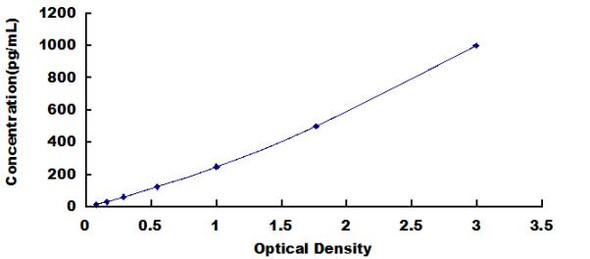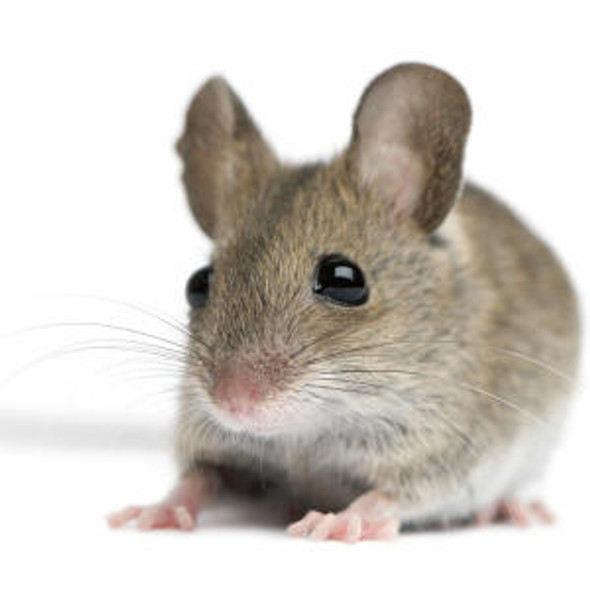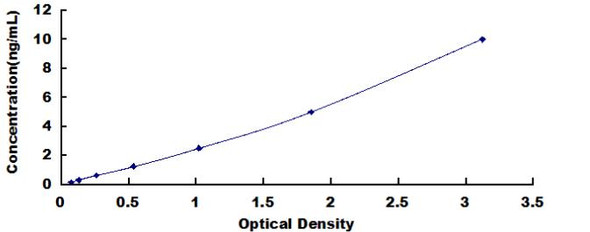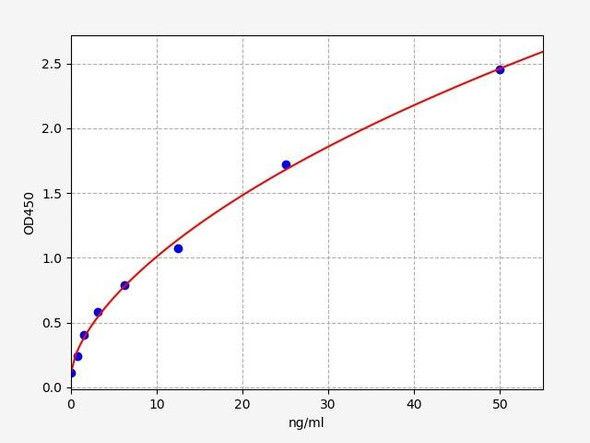Human MANF (Mesencephalic Astrocyte Derived Neurotrophic Factor) ELISA Kit (HUES01703)
- SKU:
- HUES01703
- Product Type:
- ELISA Kit
- Size:
- 96 Assays
- Uniprot:
- P55145
- Sensitivity:
- 9.38pg/mL
- Range:
- 15.63-1000pg/mL
- ELISA Type:
- Sandwich
- Synonyms:
- ARMET, Arginine Rich Mutated In Early Stage Tumors,ARP,
- Reactivity:
- Human
- Sample Type:
- Serum, plasma and other biological fluids
- Research Area:
- Metabolism
Description
Human MANF (Mesencephalic Astrocyte Derived Neurotrophic Factor) ELISA Kit
The Human MANF (Mesencephalic Astrocyte-derived Neurotrophic Factor) ELISA Kit is specially designed for the accurate measurement of MANF levels in human serum, plasma, and cell culture supernatants. This kit offers high sensitivity and specificity, ensuring dependable and consistent results for a variety of research purposes.MANF is a vital neurotrophic factor that plays a critical role in promoting cell survival and protecting against cellular stress.
It is implicated in various neurological disorders, including Parkinson's disease and stroke, making it a valuable biomarker for studying these conditions and exploring potential treatments.With its advanced technology and reliable performance, the Human MANF ELISA Kit is an essential tool for researchers looking to investigate the role of MANF in neurodegenerative diseases and develop novel therapeutic strategies.
| Assay type: | Sandwich |
| Format: | 96T |
| Assay time: | 4.5h |
| Reactivity: | Human |
| Detection Method: | Colormetric |
| Detection Range: | 15.63-1000 pg/mL |
| Sensitivity: | 9.38 pg/mL |
| Sample Volume Required Per Well: | 100µL |
| Sample Type: | Serum, plasma and other biological fluids |
| Specificity: | This kit recognizes Human MANF in samples. No significant cross-reactivity or interference between Human MANF and analogues was observed. |
This ELISA kit uses Sandwich-ELISA as the method. The micro ELISA plate provided in this kit has been pre-coated with an antibody specific to Human MANF. Standards or samples are added to the appropriate micro ELISA plate wells and combined with the specific antibody. Then a biotinylated detection antibody specific for Human MANF and Avidin-Horseradish Peroxidase (HRP) conjugate are added to each micro plate well successively and incubated. Free components are washed away. The substrate solution is added to each well. Only those wells that contain Human MANF, biotinylated detection antibody and Avidin-HRP conjugate will appear blue in color. The enzyme-substrate reaction is terminated by adding Stop Solution and the color turns yellow. The optical density (OD) is measured spectrophotometrically at a wavelength of 450 nm ± 2 nm. The OD value is proportional to the concentration of Human MANF. The concentration of Human MANF in samples can be calculated by comparing the OD of the samples to the standard curve.
| UniProt Protein Function: | ARMET: Selectively promotes the survival of dopaminergic neurons of the ventral mid-brain. Modulates GABAergic transmission to the dopaminergic neurons of the substantia nigra. Enhances spontaneous, as well as evoked, GABAergic inhibitory postsynaptic currents in dopaminergic neurons. Inhibits cell proliferation and endoplasmic reticulum (ER) stress-induced cell death. Belongs to the ARMET family. |
| UniProt Protein Details: | Protein type:Secreted; Secreted, signal peptide Chromosomal Location of Human Ortholog: 3p21. 1 Cellular Component: nucleus Disease: Pancreatic Cancer |
| NCBI Summary: | The protein encoded by this gene is localized in the endoplasmic reticulum (ER) and golgi, and is also secreted. Reducing expression of this gene increases susceptibility to ER stress-induced death and results in cell proliferation. Activity of this protein is important in promoting the survival of dopaminergic neurons. The presence of polymorphisms in the N-terminal arginine-rich region, including a specific mutation that changes an ATG start codon to AGG, have been reported in a variety of solid tumors; however, these polymorphisms were later shown to exist in normal tissues and are thus no longer thought to be tumor-related. [provided by RefSeq, Apr 2014] |
| UniProt Code: | P55145 |
| NCBI GenInfo Identifier: | 332278201 |
| NCBI Gene ID: | 7873 |
| NCBI Accession: | P55145. 3 |
| UniProt Secondary Accession: | P55145,Q14CX4, Q86U67, Q96IS4, |
| UniProt Related Accession: | P55145 |
| Molecular Weight: | 20,700 Da |
| NCBI Full Name: | Mesencephalic astrocyte-derived neurotrophic factor |
| NCBI Synonym Full Names: | mesencephalic astrocyte derived neurotrophic factor |
| NCBI Official Symbol: | MANF |
| NCBI Official Synonym Symbols: | ARP; ARMET |
| NCBI Protein Information: | mesencephalic astrocyte-derived neurotrophic factor |
| UniProt Protein Name: | Mesencephalic astrocyte-derived neurotrophic factor |
| UniProt Synonym Protein Names: | Arginine-rich protein; Protein ARMET |
| Protein Family: | MANF/CDNF-like protein |
| UniProt Gene Name: | MANF |
| UniProt Entry Name: | MANF_HUMAN |
As the OD values of the standard curve may vary according to the conditions of the actual assay performance (e. g. operator, pipetting technique, washing technique or temperature effects), the operator should establish a standard curve for each test. Typical standard curve and data is provided below for reference only.
| Concentration (pg/mL) | O.D | Average | Corrected |
| 1000 | 2.39 2.406 | 2.398 | 2.313 |
| 500 | 1.629 1.665 | 1.647 | 1.562 |
| 250 | 0.97 0.95 | 0.96 | 0.875 |
| 125 | 0.46 0.488 | 0.474 | 0.389 |
| 62.5 | 0.28 0.276 | 0.278 | 0.193 |
| 31.25 | 0.189 0.185 | 0.187 | 0.102 |
| 15.63 | 0.13 0.144 | 0.137 | 0.052 |
| 0 | 0.079 0.091 | 0.085 | -- |
Precision
Intra-assay Precision (Precision within an assay): 3 samples with low, mid range and high level Human MANF were tested 20 times on one plate, respectively.
Inter-assay Precision (Precision between assays): 3 samples with low, mid range and high level Human MANF were tested on 3 different plates, 20 replicates in each plate.
| Intra-assay Precision | Inter-assay Precision | |||||
| Sample | 1 | 2 | 3 | 1 | 2 | 3 |
| n | 20 | 20 | 20 | 20 | 20 | 20 |
| Mean (pg/mL) | 51.51 | 103.03 | 461.00 | 51.14 | 100.24 | 472.57 |
| Standard deviation | 3.11 | 4.19 | 15.07 | 3.09 | 5.77 | 24.53 |
| C V (%) | 6.04 | 4.07 | 3.27 | 6.04 | 5.76 | 5.19 |
Recovery
The recovery of Human MANF spiked at three different levels in samples throughout the range of the assay was evaluated in various matrices.
| Sample Type | Range (%) | Average Recovery (%) |
| Serum (n=5) | 96-112 | 102 |
| EDTA plasma (n=5) | 86-96 | 91 |
| Cell culture media (n=5) | 85-99 | 91 |
Linearity
Samples were spiked with high concentrations of Human MANF and diluted with Reference Standard & Sample Diluent to produce samples with values within the range of the assay.
| Serum (n=5) | EDTA plasma (n=5) | Cell culture media (n=5) | ||
| 1:2 | Range (%) | 95-112 | 85-98 | 93-107 |
| Average (%) | 103 | 91 | 99 | |
| 1:4 | Range (%) | 87-102 | 81-94 | 85-101 |
| Average (%) | 94 | 86 | 92 | |
| 1:8 | Range (%) | 90-100 | 82-93 | 88-100 |
| Average (%) | 95 | 88 | 93 | |
| 1:16 | Range (%) | 86-102 | 86-98 | 84-95 |
| Average (%) | 93 | 91 | 90 |
An unopened kit can be stored at 4°C for 1 month. If the kit is not used within 1 month, store the items separately according to the following conditions once the kit is received.
| Item | Specifications | Storage |
| Micro ELISA Plate(Dismountable) | 8 wells ×12 strips | -20°C, 6 months |
| Reference Standard | 2 vials | |
| Concentrated Biotinylated Detection Ab (100×) | 1 vial, 120 µL | |
| Concentrated HRP Conjugate (100×) | 1 vial, 120 µL | -20°C(shading light), 6 months |
| Reference Standard & Sample Diluent | 1 vial, 20 mL | 4°C, 6 months |
| Biotinylated Detection Ab Diluent | 1 vial, 14 mL | |
| HRP Conjugate Diluent | 1 vial, 14 mL | |
| Concentrated Wash Buffer (25×) | 1 vial, 30 mL | |
| Substrate Reagent | 1 vial, 10 mL | 4°C(shading light) |
| Stop Solution | 1 vial, 10 mL | 4°C |
| Plate Sealer | 5 pieces | |
| Product Description | 1 copy | |
| Certificate of Analysis | 1 copy |
- Set standard, test sample and control (zero) wells on the pre-coated plate and record theirpositions. It is recommended to measure each standard and sample in duplicate. Note: addall solutions to the bottom of the plate wells while avoiding contact with the well walls. Ensuresolutions do not foam when adding to the wells.
- Aliquot 100 µL of standard solutions into the standard wells.
- Add 100 µL of Sample / Standard dilution buffer into the control (zero) well.
- Add 100 µL of properly diluted sample (serum, plasma, tissue homogenates and otherbiological fluids) into test sample wells.
- Cover the plate with the sealer provided in the kit and incubate for 90 min at 37 °C.
- Aspirate the liquid from each well, do not wash. Immediately add 100 µL of BiotinylatedDetection Ab working solution to each well. Cover the plate with a plate seal and gently mix. Incubate for 1 hour at 37 °C.
- Aspirate or decant the solution from the plate and add 350 µL of wash buffer to each welland incubate for 1-2 minutes at room temperature. Aspirate the solution from each well andclap the plate on absorbent filter paper to dry. Repeat this process 3 times. Note: a microplatewasher can be used in this step and other wash steps.
- Add 100 µL of HRP Conjugate working solution to each well. Cover with a plate seal andincubate for 30 min at 37 °C.
- Aspirate or decant the solution from each well. Repeat the wash process for five times asconducted in step 7.
- Add 90 µL of Substrate Reagent to each well. Cover with a new plate seal and incubate forapproximately 15 min at 37 °C. Protect the plate from light. Note: the reaction time can beshortened or extended according to the actual color change, but not by more than 30min.
- Add 50 µL of Stop Solution to each well. Note: Adding the stop solution should be done inthe same order as the substrate solution.
- Determine the optical density (OD value) of each well immediately with a microplate readerset at 450 nm.








